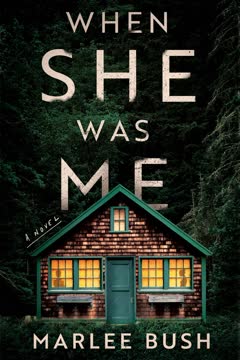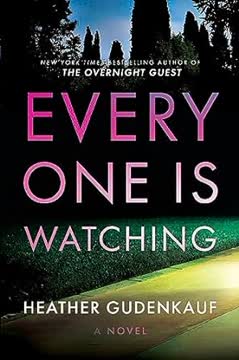Plot Summary
Twin Shadows, Twin Secrets
Cassie and Lenora, identical twins, live isolated in a Tennessee campground, bound by a traumatic past and a codependent relationship. Their lives are shaped by a childhood tragedy involving their parents, a fire, and a night that left them both scarred. Cassie is the protector, outwardly strong, while Lenora is fragile, agoraphobic, and wracked with guilt. Their sameness is both comfort and curse, as each sees herself reflected in the other's wounds and secrets. The sisters' days are marked by routines, unspoken rules, and the constant tension of what they remember—and what they refuse to face—about the night that changed everything. Their connection is both their salvation and their prison.
The Campground's Uneasy Peace
The sisters' world is the nearly abandoned campground, a place once lively but now haunted by memories and the occasional visitor. Cassie manages their survival, working on her true crime channel, while Lenora rarely leaves the cabin, her anxiety tethering her to the past. The recent death of Wayne, the old caretaker, unsettles their fragile peace, and the arrival of a new owner, Sarah, brings both hope and unease. The woods are both sanctuary and threat, filled with the ghosts of their history and the possibility of new dangers. The sisters' routines are disrupted, and the sense of safety they've built begins to erode.
Watching and Being Watched
Lenora's compulsion to watch others from her window is mirrored by Cassie's obsession with telling victims' stories on her channel. Both sisters are voyeurs, seeking control and understanding through observation. The arrival of Tilly, a teenage guest, and her family in Cabin Three, gives Lenora a new focus. She becomes fixated on Tilly, seeing in her both freedom and vulnerability. Cassie, meanwhile, is drawn to Sarah, the enigmatic new owner. The act of watching becomes a way to process trauma, but it also blurs boundaries, making the sisters both witnesses and participants in the unfolding drama.
Ghosts of the Past
Flashbacks reveal the sisters' childhood: a home filled with violence, neglect, and secrets. Their father's addiction and their mother's coldness set the stage for the tragedy that would define them. The fire that destroyed their family is a recurring nightmare, its details shifting with each retelling. Cassie remembers herself as the protector, but guilt gnaws at her for not saving Lenora. Lenora's memories are fragmented, her sense of self shaped by what she did—and didn't—do that night. The past is a living presence, infecting their present and threatening to unravel their bond.
The New Neighbor Arrives
Sarah, the new owner, is friendly but mysterious, her interest in the twins both genuine and unsettling. She offers stability, but her past is opaque. Cassie is drawn to her, sensing a kindred spirit, while Lenora is wary, her anxiety heightened by the sense that Sarah is watching them as closely as they watch her. The dynamic between the three women is fraught, with undercurrents of attraction, suspicion, and the longing for connection. Sarah's arrival marks a turning point, as old patterns are disrupted and new dangers begin to surface.
Tilly Disappears
Tilly, the rebellious teenager from Cabin Three, vanishes after a fight with her mother. The campground is thrown into chaos as police and volunteers search the woods. Cassie and Lenora are drawn into the investigation, their own secrets making them both suspects and bystanders. Lenora's sleepwalking and fragmented memories make her doubt her own innocence, while Cassie's protective instincts are tested as she tries to shield her sister from suspicion. The disappearance exposes the fault lines in every relationship on the campground, and the sisters' fragile peace is shattered.
Sleepwalking and Suspicion
As the search for Tilly intensifies, Lenora's sleepwalking episodes grow more frequent and disturbing. She wakes covered in mud, with no memory of where she's been. Cassie finds Lenora's coin at the Blacktop, the site of Tilly's last known whereabouts, and begins to fear what her sister might be capable of. The line between victim and perpetrator blurs, and both sisters are forced to confront the possibility that the greatest threat may come from within. Their trust in each other is tested as suspicion and fear take root.
The Search and the Storm
A violent storm descends on the campground as the search for Tilly reaches a fever pitch. The woods become a labyrinth of fear and memory, with volunteers, police, and the sisters themselves searching for answers. Cassie's guilt over her own secrets—her relationship with Parker, her doubts about Lenora—mounts, while Lenora is haunted by visions and the sense that she is being watched. The storm is both literal and metaphorical, a cleansing force that brings hidden truths to the surface and sets the stage for tragedy.
The Body in the Woods
Tilly's body is found near the Blacktop, her death ruled a homicide. The sisters are questioned by detectives, their every word and gesture scrutinized. Lenora's account of the night is incomplete, her memory unreliable. Cassie tries to hold them together, but the weight of suspicion and grief is crushing. The campground becomes a crime scene, and the sisters' isolation deepens. The discovery of the body is not an ending, but the beginning of a new nightmare, as guilt, blame, and fear threaten to destroy what remains of their bond.
Guilt, Grief, and Blame
The aftermath of Tilly's death is a tangle of accusations and recriminations. Tilly's parents lash out at the sisters, convinced they know more than they're saying. Cassie and Lenora turn on each other, their old wounds reopened by the pressure of the investigation. Sarah's behavior grows more erratic, her own secrets coming to light. The line between protector and perpetrator blurs, as each character is forced to confront the darkness within themselves. The sisters' codependency becomes both a shield and a weapon, as they struggle to survive in a world that sees them as both victims and threats.
The Unraveling Sisters
Cassie and Lenora's relationship reaches a breaking point as secrets are revealed and trust is shattered. Cassie's hidden collection of other people's discarded objects, Lenora's obsession with watching and researching, and their shared history of violence and cover-ups come to the fore. The arrival of new evidence—and the realization that Sarah is not who she claims to be—pushes them to the edge. The sisters must decide whether to protect each other at all costs, or to finally face the truth about what they have done and what they are capable of.
The Bunker Below
The search for answers leads Cassie and Lenora to a hidden bunker beneath the campground, where Sarah's true identity—and the existence of her dangerous sister, Emily—are revealed. Emily, a mirror of Lenora's own darkness, is responsible for Tilly's death and other crimes. Sarah, desperate to protect her sister, has kept her hidden, but can no longer control her. The twins are trapped, forced to fight for their lives against a foe who is both other and self. The confrontation is brutal, forcing each sister to confront the violence within and the lengths they will go to for each other.
The Truth of Blood
In the bunker, the truth of the past is laid bare: the violence that shaped Cassie and Lenora, the choices that made them who they are, and the legacy of blood that binds and curses them. The sisters' survival depends on their willingness to face the truth—not just about Sarah and Emily, but about themselves and their own family history. The final confrontation is both physical and psychological, a reckoning with the ghosts of their parents, the fire, and the lies they have told to survive. In the end, only by accepting the darkness within can they hope to break free.
Aftermath and Reckoning
The immediate threat is gone, but the sisters are left to pick up the pieces. Sarah is arrested, Emily is dead, and the campground is once again empty. Cassie and Lenora must reckon with what they have done—and what they have become. The media descends, and the sisters are forced to relive their trauma for a public hungry for true crime. Their relationship is changed, but not broken; they are bound by what they have survived, and by the secrets they still keep. The question of guilt and innocence remains unresolved, as does the question of whether they can ever truly escape their past.
The Weight of Survival
In the weeks that follow, Cassie and Lenora struggle to find a new equilibrium. Cassie is offered a book deal, Lenora begins to venture outside, and both try to imagine a future beyond the campground. The scars of the past remain, and the question of whether they are victims or perpetrators lingers. Their love for each other is both their greatest strength and their greatest weakness, a bond forged in blood and fire. As they prepare to leave the campground behind, they must decide what kind of life they want to build—and whether they can ever truly be free of the darkness that shaped them.
Letting Go, Moving On
The sisters sit together one last time at the Blacktop, the site of so much pain and memory. They reflect on what they have lost and what they have survived, acknowledging the complexity of their bond and the impossibility of simple answers. Cassie prepares to leave for a new life, while Lenora stays behind, each carrying the weight of their shared history. The past cannot be undone, but the future is unwritten. In the end, their survival is not just a matter of escaping danger, but of learning to live with themselves—and with each other.
Characters
Cassie Lowe
Cassie is the outwardly strong twin, fiercely protective of Lenora and determined to control their world. She channels her trauma into her true crime channel, focusing on victims' stories as a way to process her own pain and guilt. Cassie's need to protect Lenora is both genuine love and a way to atone for her perceived failures on the night their family was destroyed. She is resourceful, blunt, and sometimes emotionally distant, hiding her own vulnerabilities behind routines and sarcasm. Cassie's psychological complexity lies in her struggle to reconcile her role as both victim and enabler, and her fear that she is as damaged as the people she studies. Her development is marked by a gradual acceptance of her own darkness and the realization that survival sometimes means letting go.
Lenora Lowe
Lenora is the more visibly damaged twin, suffering from agoraphobia, anxiety, and a compulsion to watch others. She is wracked with guilt over her role in the family tragedy and is often paralyzed by indecision and fear. Lenora's psychological landscape is shaped by trauma, self-doubt, and a desperate need for connection. Her obsession with watching is both a coping mechanism and a symptom of her inability to engage directly with the world. Lenora's relationship with Cassie is both her lifeline and her prison, as she relies on her sister for survival but resents the control and secrecy that come with it. Over the course of the story, Lenora is forced to confront the possibility that she is not just a victim, but also a perpetrator, and to accept the complexity of her own nature.
Sarah Hill / Sandra Wells
Sarah arrives as the new owner of the campground, offering stability and friendship but hiding a dark past. In reality, she is Sandra Wells, a survivor of her own family's tragedy, who has spent years protecting her dangerous sister, Emily. Sarah's psychological profile is defined by guilt, denial, and a desperate need to control the uncontrollable. She sees herself in Cassie and Lenora, and her attempts to help them are both genuine and self-serving. Sarah's relationship with Emily mirrors the twins' bond, highlighting the dangers of unconditional loyalty and the impossibility of escaping the past. Her development is a slow unraveling, as her secrets are exposed and her ability to protect her sister—and herself—collapses.
Emily Wells
Emily is Sarah's younger sister, kept hidden in a secret room beneath the campground. She is responsible for Tilly's death and other crimes, her violence both a symptom of mental illness and a reflection of the trauma she has endured. Emily is both victim and perpetrator, her actions shaped by a lifetime of secrecy, isolation, and failed attempts at rehabilitation. She is a dark mirror for Lenora, embodying the fear that trauma inevitably leads to violence. Emily's relationship with Sarah is both loving and destructive, a bond that ultimately leads to tragedy. Her presence forces the other characters to confront the limits of love, forgiveness, and responsibility.
Tilly Meadows
Tilly is a guest at the campground, whose disappearance and death set the plot in motion. She is both a symbol of freedom and a victim of circumstance, her rebelliousness masking vulnerability and a troubled relationship with her mother. Tilly's interactions with Lenora and Cassie reveal the sisters' longing for normalcy and connection, as well as their inability to escape the patterns of their own past. In death, Tilly becomes a focal point for guilt, blame, and the search for meaning, her story echoing the unresolved traumas of the other characters.
Karen Meadows
Karen is Tilly's mother, whose relationship with her daughter is fraught with conflict and misunderstanding. Her grief and anger make her both a suspect and a victim, as she lashes out at the sisters and becomes entangled in the investigation. Karen's actions are driven by guilt, denial, and a desperate need for answers, mirroring the psychological struggles of Cassie, Lenora, and Sarah. Her presence forces the other characters to confront the consequences of violence and the impossibility of simple resolutions.
Parker
Parker is a guest-turned-lover who offers Cassie a glimpse of a life beyond the campground. He is attentive, caring, and increasingly frustrated by Cassie's secrecy and emotional distance. Parker's presence highlights the sisters' isolation and the difficulty of forming healthy relationships in the aftermath of trauma. He serves as a foil to Cassie, challenging her to confront her own needs and desires, and ultimately forcing her to choose between the safety of the past and the possibility of a future.
Wayne
Wayne is the original owner of the campground, whose death sets the story in motion. He is a relic of a bygone era, his eccentricities and paranoia both comic and tragic. Wayne's presence lingers after his death, his secrets and survivalist preparations foreshadowing the dangers that lie beneath the surface. He is a reminder of the ways in which the past refuses to stay buried, and the inevitability of decay and loss.
The Lowe Parents
Cassie and Lenora's parents are the unseen architects of their daughters' suffering. Their father's addiction and their mother's coldness and eventual violence set the stage for the tragedy that defines the sisters' lives. The parents are both victims and perpetrators, their own traumas passed down and magnified in their children. Their legacy is a cycle of pain, secrecy, and the desperate search for love and meaning.
Monica
Monica is a figure from Sarah and Emily's past, a friend who becomes a victim of Emily's violence. Her death is a turning point, forcing Sarah to confront the reality of her sister's illness and the impossibility of protecting her forever. Monica's story echoes that of Tilly, highlighting the ways in which innocence is destroyed by secrets and the failure to confront the truth.
Plot Devices
Dual Timelines and Unreliable Narration
The novel employs a dual timeline structure, alternating between the present-day events at the campground and flashbacks to the sisters' childhood. The narration is deliberately unreliable, with Cassie and Lenora each offering partial, contradictory, and evolving accounts of the past. This structure creates suspense and ambiguity, forcing the reader to question what is real and what is imagined. The gradual revelation of key events—such as the fire, the deaths of their parents, and the true nature of their bond—mirrors the characters' own struggle to make sense of their trauma. The use of voyeurism, both literal and metaphorical, blurs the line between observer and participant, victim and perpetrator.
Foreshadowing and Symbolism
The campground itself is a symbol of isolation, decay, and the impossibility of escape. Objects such as Lenora's coin, Cassie's collection of discarded items, and the hidden bunker serve as physical manifestations of memory, guilt, and the secrets that bind the characters. The recurring imagery of fire, blood, and mirrors underscores the themes of destruction, transformation, and self-reflection. Foreshadowing is used to build tension, with early hints of violence, sleepwalking, and hidden rooms paying off in the story's climactic revelations.
Mirroring and Doubling
The novel is structured around pairs: Cassie and Lenora, Sarah and Emily, Tilly and Karen. Each pair reflects and distorts the others, highlighting the ways in which love, loyalty, and violence are intertwined. The doubling of characters and events creates a sense of inevitability, as the sins of the past are repeated in the present. The mirroring extends to the narrative itself, with the sisters' stories echoing and refracting each other, making it difficult to distinguish between self and other, truth and lie.
Psychological Suspense and Slow-Burn Mystery
The story unfolds as a slow-burn mystery, with the disappearance of Tilly, the secrets of the past, and the true nature of Sarah and Emily all revealed piece by piece. Suspense is maintained through shifting suspicion, unreliable memories, and the constant threat of violence. The emotional intensity is heightened by the claustrophobic setting, the sisters' codependency, and the ever-present possibility that the greatest danger comes from within.
Analysis
When She Was Me is a psychological thriller that uses the framework of a murder mystery to explore the enduring effects of childhood trauma, the complexity of sibling bonds, and the blurred line between victim and perpetrator. The novel interrogates the ways in which secrets, guilt, and love can both save and destroy, and how the past refuses to stay buried. Through its dual timelines, unreliable narration, and mirroring of relationships, the book challenges readers to question the nature of truth, memory, and identity. The sisters' journey is both a literal and metaphorical descent into darkness, culminating in a reckoning with the violence that shaped them. Ultimately, the novel suggests that survival is not just about escaping danger, but about learning to live with the darkness within—and that healing, if it comes at all, is a slow, uncertain process. The story is a meditation on the cost of loyalty, the dangers of denial, and the possibility of redemption, even for those who have been most deeply wounded.
Last updated:
Review Summary
When She Was Me is a psychological thriller about twin sisters living in an isolated cabin. Many readers found it gripping and twisty, praising the atmospheric setting and unreliable narrators. The slow-burn pacing and repetitive writing divided opinions. Some loved the suspenseful build-up and shocking ending, while others found it confusing and boring. The book explores themes of trauma, sisterly bonds, and perception vs. reality. Overall, reviewers appreciated the debut's potential despite mixed feelings about the execution.
Similar Books
Download PDF
Download EPUB
.epub digital book format is ideal for reading ebooks on phones, tablets, and e-readers.












